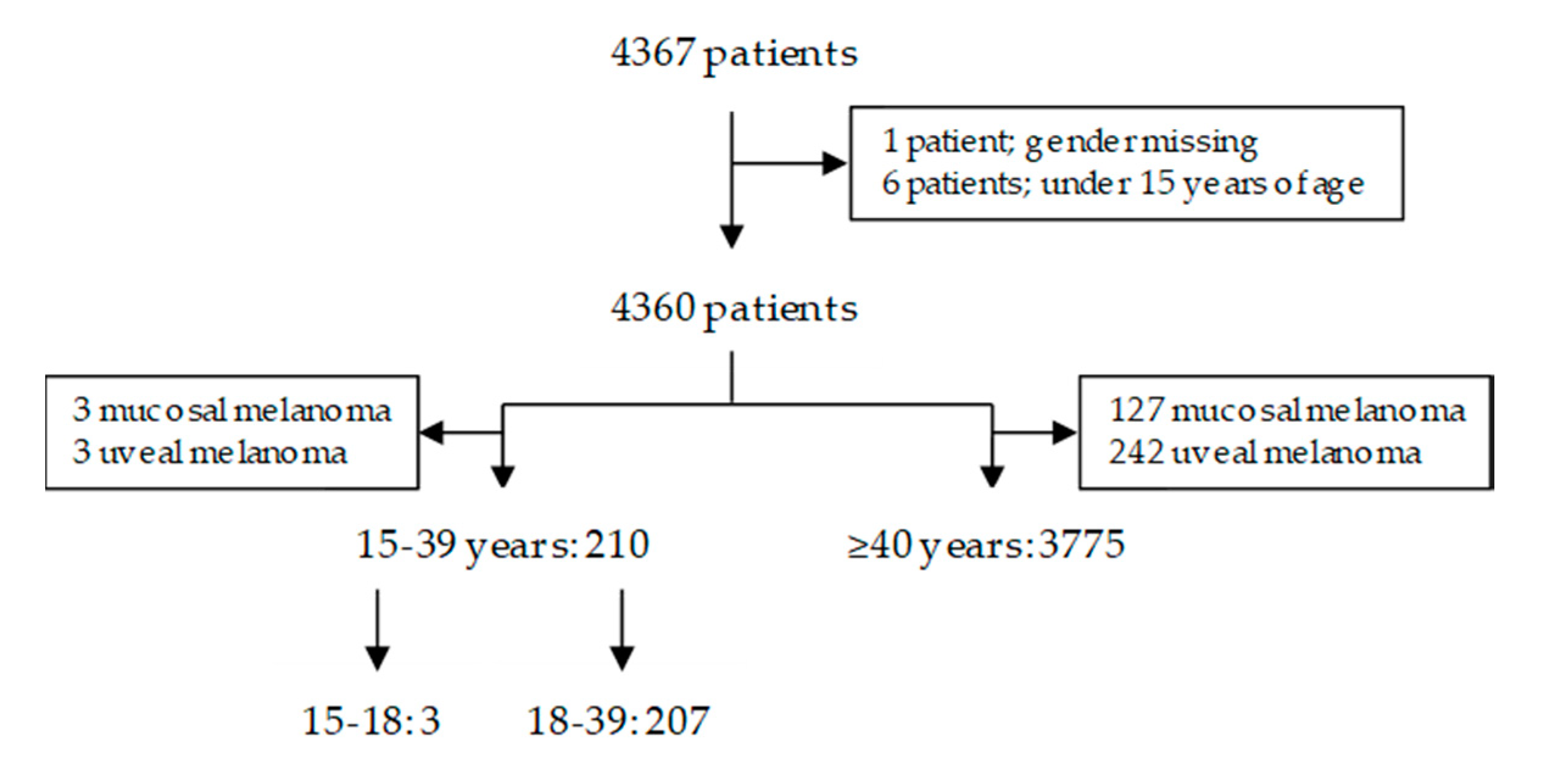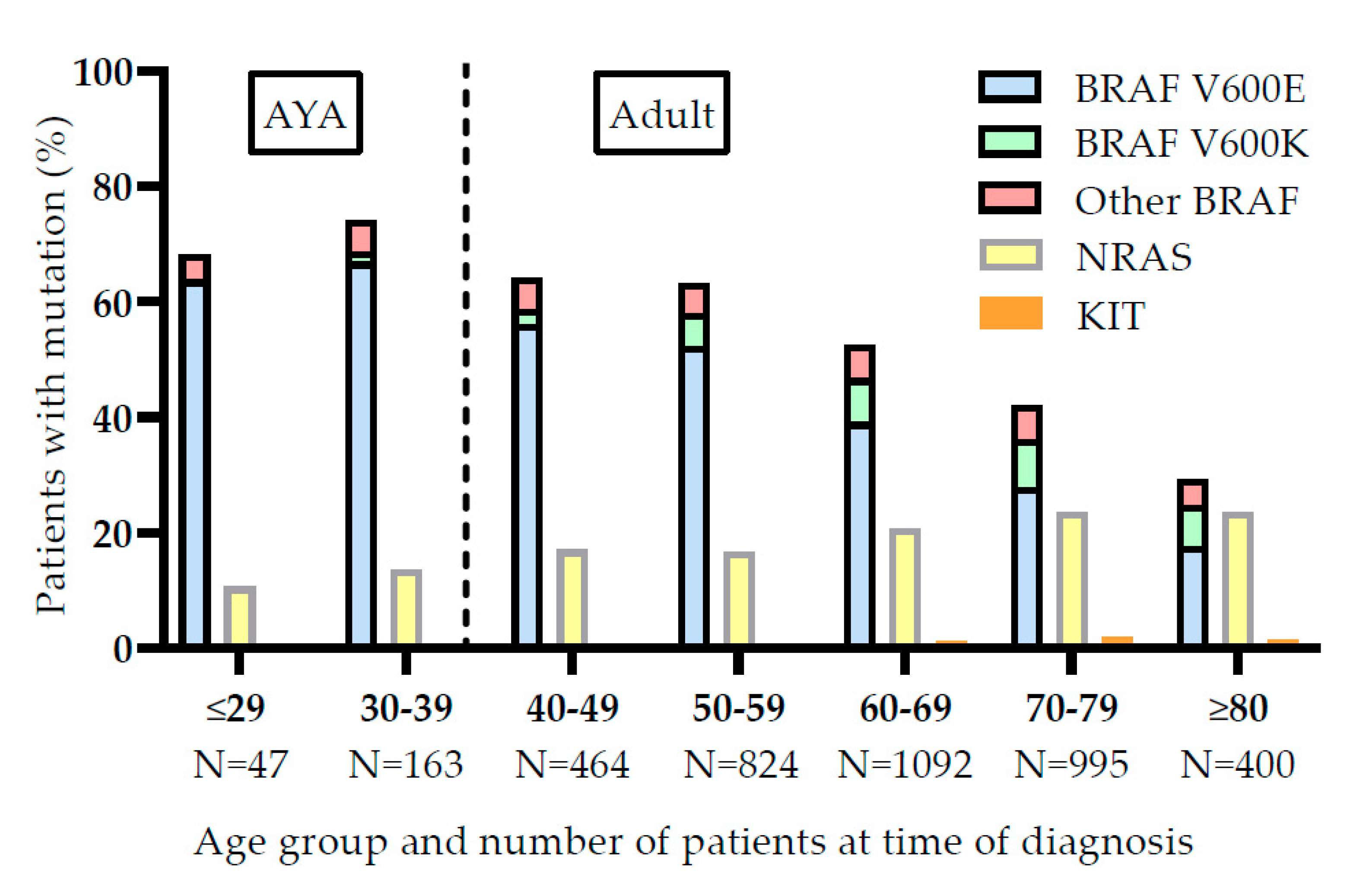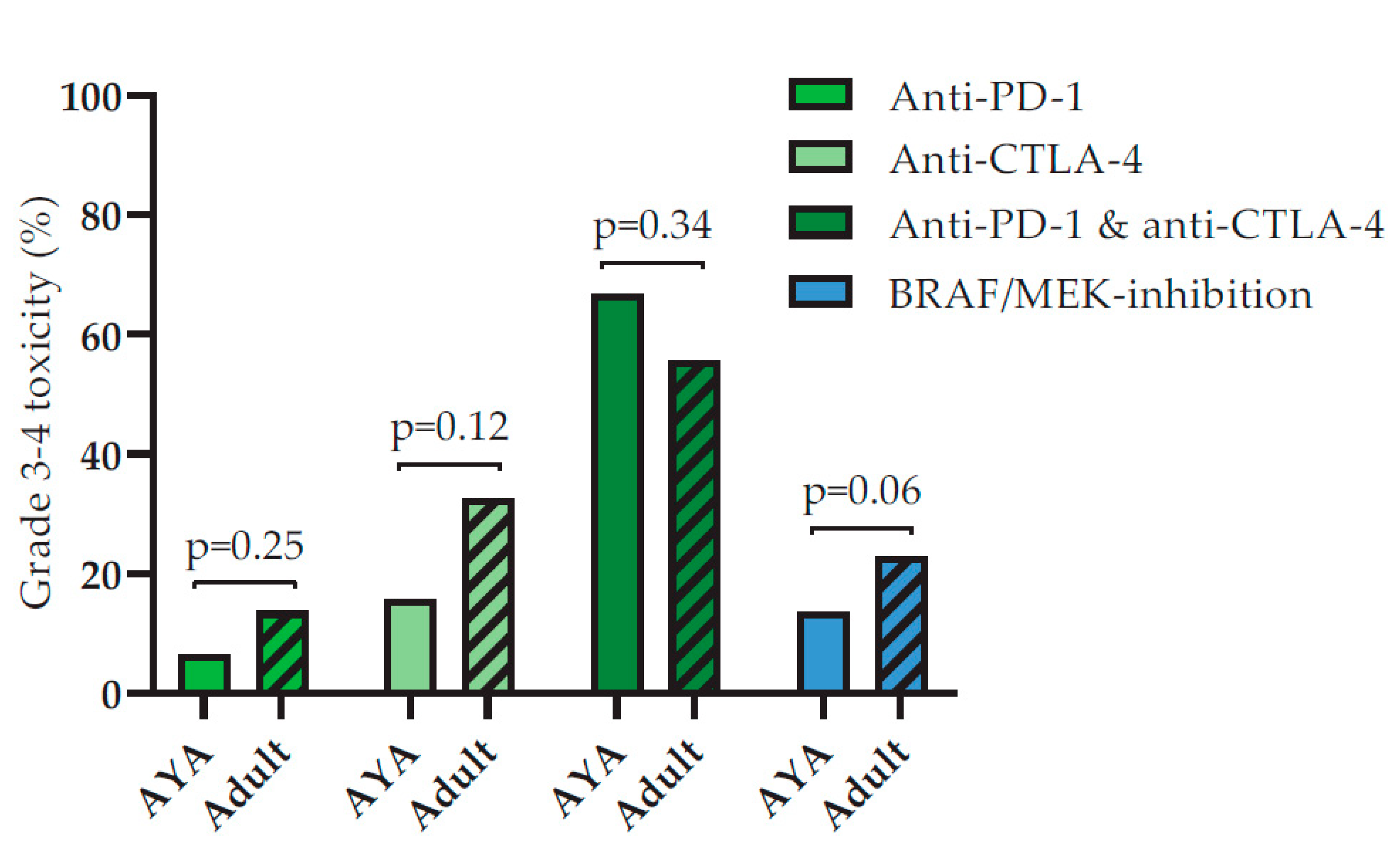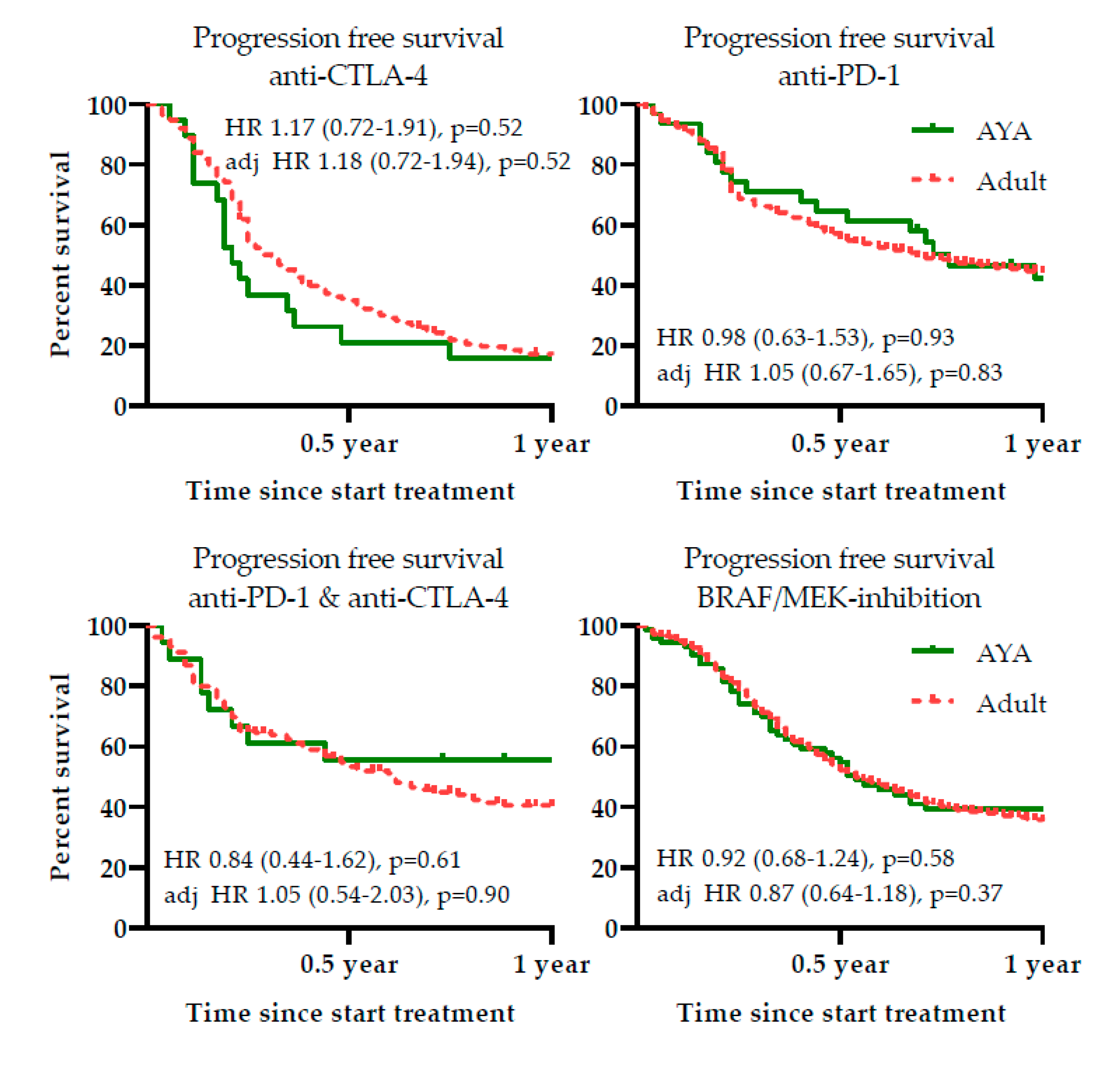Age Does Matter in Adolescents and Young Adults versus Older Adults with Advanced Melanoma; A National Cohort Study Comparing Tumor Characteristics, Treatment Pattern, Toxicity and Response
Abstract
1. Introduction
2. Results
2.1. Patient Selection and Baseline Characteristics
2.2. Tumor Mutations
2.3. Initial Treatment
2.4. Treatment Toxicity
2.5. Response to Systemic Treatment
2.6. Survival
3. Discussion
4. Materials and Methods
4.1. Data Source
4.2. Patients
4.3. Statistical Analysis
5. Conclusions
Supplementary Materials
Author Contributions
Funding
Conflicts of Interest
References
- GLOBOCAN 2012 v1.0, Cancer Incidence and Mortality Worldwide: IARC CancerBase No. 11. Available online: http://globocan.iarc.fr (accessed on 15 July 2020).
- Siegel, R.L.; Miller, K.D.; Jemal, A. Cancer statistics, 2019. CA. Cancer J. Clin. 2019, 69, 7–34. [Google Scholar] [CrossRef]
- Hauschild, A.; Grob, J.-J.; Demidov, L.V.; Jouary, T.; Gutzmer, R.; Millward, M.; Rutkowski, P.; Blank, C.U.; Miller, W.H.; Kaempgen, E.; et al. Dabrafenib in BRAF-mutated metastatic melanoma: A multicentre, open-label, phase 3 randomised controlled trial. Lancet 2012, 380, 358–365. [Google Scholar] [CrossRef]
- Chapman, P.B.; Hauschild, A.; Robert, C.; Haanen, J.B.; Ascierto, P.; Larkin, J.; Dummer, R.; Garbe, C.; Testori, A.; Maio, M.; et al. Improved Survival with Vemurafenib in Melanoma with BRAF V600E Mutation. N. Engl. J. Med. 2011, 364, 2507–2516. [Google Scholar] [CrossRef]
- Wolchok, J.D.; Chiarion-Sileni, V.; Gonzalez, R.; Rutkowski, P.; Grob, J.-J.; Cowey, C.L.; Lao, C.D.; Wagstaff, J.; Schadendorf, D.; Ferrucci, P.F.; et al. Overall Survival with Combined Nivolumab and Ipilimumab in Advanced Melanoma. N. Engl. J. Med. 2017, 377, 1345–1356. [Google Scholar] [CrossRef]
- Carlino, M.S.; Long, G.V.; Schadendorf, D.; Robert, C.; Ribas, A.; Richtig, E.; Nyakas, M.; Caglevic, C.; Tarhini, A.; Blank, C.; et al. Outcomes by line of therapy and programmed death ligand 1 expression in patients with advanced melanoma treated with pembrolizumab or ipilimumab in KEYNOTE-006: A randomised clinical trial. Eur. J. Cancer 2018, 101, 236–243. [Google Scholar] [CrossRef]
- Hamid, O.; Puzanov, I.; Dummer, R.; Schachter, J.; Daud, A.; Schadendorf, D.; Blank, C.; Cranmer, L.D.; Robert, C.; Pavlick, A.C.; et al. Final analysis of a randomised trial comparing pembrolizumab versus investigator-choice chemotherapy for ipilimumab-refractory advanced melanoma. Eur. J. Cancer 2017, 86, 37–45. [Google Scholar] [CrossRef]
- Larkin, J.; Minor, D.; D’Angelo, S.; Neyns, B.; Smylie, M.; Miller, W.H.; Gutzmer, R.; Linette, G.; Chmielowski, B.; Lao, C.D.; et al. Overall Survival in Patients With Advanced Melanoma Who Received Nivolumab Versus Investigator’s Choice Chemotherapy in CheckMate 037: A Randomized, Controlled, Open-Label Phase III Trial. J. Clin. Oncol. 2018, 36, 383–390. [Google Scholar] [CrossRef]
- Daryanani, D.; Plukker, J.T.; Nap, R.E.; Kuiper, H.; Hoekstra, H.J. Adolescent melanoma: Risk factors and long term survival. Eur. J. Surg. Oncol. 2006, 32, 218–223. [Google Scholar] [CrossRef]
- Indini, A.; Brecht, I.; Del Vecchio, M.; Sultan, I.; Signoroni, S.; Ferrari, A. Cutaneous melanoma in adolescents and young adults. Pediatr. Blood Cancer 2018, 65, e27292. [Google Scholar] [CrossRef]
- Seynnaeve, B.; Lee, S.; Borah, S.; Park, Y.; Pappo, A.; Kirkwood, J.M.; Bahrami, A. Genetic and Epigenetic Alterations of TERT Are Associated with Inferior Outcome in Adolescent and Young Adult Patients with Melanoma. Sci. Rep. 2017, 7, 45704. [Google Scholar] [CrossRef]
- Menzies, A.M.; Haydu, L.E.; Visintin, L.; Carlino, M.S.; Howle, J.R.; Thompson, J.F.; Kefford, R.F.; Scolyer, R.A.; Long, G.V. Distinguishing clinicopathologic features of patients with V600E and V600K BRAF-mutant metastatic melanoma. Clin Cancer Res. 2012, 18, 3242–3249. [Google Scholar] [CrossRef] [PubMed]
- Wilmott, J.S.; Johansson, P.A.; Newell, F.; Waddell, N.; Ferguson, P.; Quek, C.; Patch, A.-M.; Nones, K.; Shang, P.; Pritchard, A.L.; et al. Whole genome sequencing of melanomas in adolescent and young adults reveals distinct mutation landscapes and the potential role of germline variants in disease susceptibility. Int. J. Cancer 2019, 144, 1049–1060. [Google Scholar] [CrossRef] [PubMed]
- Hajdarevic, S.; Schmitt-Egenolf, M.; Brulin, C.; Sundbom, E.; Hörnsten, Å. Malignant melanoma: Gender patterns in care seeking for suspect marks. J. Clin. Nurs. 2011, 20, 2676–2684. [Google Scholar] [CrossRef] [PubMed]
- Giblin, A.-V.; Thomas, J.M. Incidence, mortality and survival in cutaneous melanoma. J. Plast. Reconstr. Aesthetic Surg. 2007, 60, 32–40. [Google Scholar] [CrossRef] [PubMed]
- Donley, G.M.; Liu, W.T.; Pfeiffer, R.M.; McDonald, E.C.; Peters, K.O.; Tucker, M.A.; Cahoon, E.K. Reproductive factors, exogenous hormone use and incidence of melanoma among women in the United States. Br. J. Cancer 2019, 120, 754–760. [Google Scholar] [CrossRef]
- Smith, M.A.; Fine, J.A.; Barnhill, R.L.; Berwick, M. Hormonal and reproductive influences and risk of melanoma in women. Int. J. Epidemiol. 1998, 27, 751–757. [Google Scholar] [CrossRef]
- Støer, N.C.; Botteri, E.; Ghiasvand, R.; Busund, M.; Vangen, S.; Lund, E.; Veierød, M.B.; Weiderpass, E. Reproductive factors and risk of melanoma: a population-based cohort study. Br. J. Dermatol. 2019, 181, 282–289. [Google Scholar] [CrossRef]
- Verzì, A.E.; Bubley, J.A.; Haugh, A.M.; Zhang, B.; Wagner, A.; Kruse, L.; West, D.P.; Wayne, J.; Guitart, J.; Gerami, P. A single-institution assessment of superficial spreading melanoma (SSM) in the pediatric population: Molecular and histopathologic features compared with adult SSM. J. Am. Acad. Dermatol. 2017, 77, 886–892. [Google Scholar] [CrossRef]
- Bartenstein, D.W.; Kelleher, C.M.; Friedmann, A.M.; Duncan, L.M.; Tsao, H.; Sober, A.J.; Hawryluk, E.B. Contrasting features of childhood and adolescent melanomas. Pediatr. Dermatol. 2018, 35, 354–360. [Google Scholar] [CrossRef]
- Livestro, D.P.; Kaine, E.M.; Michaelson, J.S.; Mihm, M.C.; Haluska, F.G.; Muzikansky, A.; Sober, A.J.; Tanabe, K.K. Melanoma in the young: Differences and similarities with adult melanoma. Cancer 2007, 110, 614–624. [Google Scholar] [CrossRef]
- Bauer, J.; Büttner, P.; Murali, R.; Okamoto, I.; Kolaitis, N.A.; Landi, M.T.; Scolyer, R.A.; Bastian, B.C. BRAF mutations in cutaneous melanoma are independently associated with age, anatomic site of the primary tumor, and the degree of solar elastosis at the primary tumor site. Pigment Cell Melanoma Res. 2011, 24, 345–351. [Google Scholar] [CrossRef] [PubMed]
- Matson, V.; Fessler, J.; Bao, R.; Chongsuwat, T.; Zha, Y.; Alegre, M.-L.; Luke, J.J.; Gajewski, T.F. The commensal microbiome is associated with anti-PD-1 efficacy in metastatic melanoma patients. Science 2018, 359, 104–108. [Google Scholar] [CrossRef] [PubMed]
- Dubin, K.; Callahan, M.K.; Ren, B.; Khanin, R.; Viale, A.; Ling, L.; No, D.; Gobourne, A.; Littmann, E.; Huttenhower, C.; et al. Intestinal microbiome analyses identify melanoma patients at risk for checkpoint-blockade-induced colitis. Nat. Commun. 2016, 7, 10391. [Google Scholar] [CrossRef] [PubMed]
- Nagpal, R.; Mainali, R.; Ahmadi, S.; Wang, S.; Singh, R.; Kavanagh, K.; Kitzman, D.W.; Kushugulova, A.; Marotta, F.; Yadav, H. Gut microbiome and aging: Physiological and mechanistic insights. Nutr. Heal. Aging 2018, 4, 267–285. [Google Scholar] [CrossRef]
- Mariat, D.; Firmesse, O.; Levenez, F.; Guimarăes, V.; Sokol, H.; Doré, J.; Corthier, G.; Furet, J.-P. The Firmicutes/Bacteroidetes ratio of the human microbiota changes with age. BMC Microbiol. 2009, 9, 123. [Google Scholar] [CrossRef]
- Fuentes, E.; Fuentes, M.; Alarcón, M.; Palomo, I. Immune System Dysfunction in the Elderly. An. Acad. Bras. Cienc. 2017, 89, 285–299. [Google Scholar] [CrossRef]
- Simon, A.K.; Hollander, G.A.; McMichael, A. Evolution of the immune system in humans from infancy to old age. Proc. R. Soc. B Biol. Sci. 2015, 282, 20143085. [Google Scholar] [CrossRef]
- Sadighi Akha, A.A. Aging and the immune system: An overview. J. Immunol. Methods 2018, 463, 21–26. [Google Scholar] [CrossRef]
- van den Brom, R.R.H.; van der Geest, K.S.M.; Brouwer, E.; Hospers, G.A.P.; Boots, A.M.H. Enhanced expression of PD-1 and other activation markers by CD4+ T cells of young but not old patients with metastatic melanoma. Cancer Immunol. Immunother. 2018, 67, 925–933. [Google Scholar] [CrossRef]
- Krauthammer, M.; Kong, Y.; Bacchiocchi, A.; Evans, P.; Pornputtapong, N.; Wu, C.; McCusker, J.P.; Ma, S.; Cheng, E.; Straub, R.; et al. Exome sequencing identifies recurrent mutations in NF1 and RASopathy genes in sun-exposed melanomas. Nat. Genet. 2015, 47, 996–1002. [Google Scholar] [CrossRef]
- Jochems, A.; Schouwenburg, M.G.; Leeneman, B.; Franken, M.G.; van den Eertwegh, A.J.M.; Haanen, J.B.A.G.; Gelderblom, H.; Uyl-de Groot, C.A.; Aarts, M.J.B.; van den Berkmortel, F.W.P.J.; et al. Dutch Melanoma Treatment Registry: Quality assurance in the care of patients with metastatic melanoma in the Netherlands. Eur. J. Cancer 2017, 72, 156–165. [Google Scholar] [CrossRef]
- Sender, L.; Zabokrtsky, K.B. Adolescent and young adult patients with cancer: a milieu of unique features. Nat. Rev. Clin. Oncol. 2015, 12, 465–480. [Google Scholar] [CrossRef] [PubMed]
- Edge, S.B.; Compton, C.C. The American Joint Committee on Cancer: the 7th Edition of the AJCC Cancer Staging Manual and the Future of TNM. Ann. Surg. Oncol. 2010, 17, 1471–1474. [Google Scholar] [CrossRef]
- Majewski, W.; Stanienda, K.; Wicherska, K.; Ulczok, R.; Wydmanski, J. Treatment Outcome and Prognostic Factors for Malignant Skin Melanoma Treated with Radical Surgery. Asian Pacific J. Cancer Prev. 2015, 16, 5709–5714. [Google Scholar] [CrossRef][Green Version]
- Farahi, J.M.; Fazzari, M.; Braunberger, T.; Caravaglio, J.V.; Kretowicz, A.; Wells, K.; Dellavalle, R.P.; Norris, D.; Alkousakis, T. Gender differences in melanoma prognostic factors. Dermatol. Online J. 2018, 24. [Google Scholar]
- Hauschild, A.; Larkin, J.; Ribas, A.; Dréno, B.; Flaherty, K.T.; Ascierto, P.A.; Lewis, K.D.; McKenna, E.; Zhu, Q.; Mun, Y.; et al. Modeled Prognostic Subgroups for Survival and Treatment Outcomes in BRAF V600–Mutated Metastatic Melanoma. JAMA Oncol. 2018, 4, 1382. [Google Scholar] [CrossRef] [PubMed]
- Lattanzi, M.; Lee, Y.; Simpson, D.; Moran, U.; Darvishian, F.; Kim, R.H.; Hernando, E.; Polsky, D.; Hanniford, D.; Shapiro, R.; et al. Primary Melanoma Histologic Subtype: Impact on Survival and Response to Therapy. JNCI J. Natl. Cancer Inst. 2019, 111, 180–188. [Google Scholar] [CrossRef] [PubMed]
- Schemper, M.; Smith, T.L. A note on quantifying follow-up in studies of failure time. Control. Clin. Trials 1996, 17, 343–346. [Google Scholar] [CrossRef]
- de Glas, N.A.; Kiderlen, M.; Vandenbroucke, J.P.; de Craen, A.J.M.; Portielje, J.E.A.; van de Velde, C.J.H.; Liefers, G.-J.; Bastiaannet, E.; Le Cessie, S. Performing Survival Analyses in the Presence of Competing Risks: A Clinical Example in Older Breast Cancer Patients. J. Natl. Cancer Inst. 2016, 108, djv366. [Google Scholar] [CrossRef]
- Putter, H.; Fiocco, M.; Geskus, R.B. Tutorial in biostatistics: Competing risks and multi-state models. Stat. Med. 2007, 26, 2389–2430. [Google Scholar] [CrossRef]





| Characteristic | AYA | Older adult | p-Value |
|---|---|---|---|
| Patients; n | 210 | 3775 | |
| Median age, year (range) | 34 (15–39) | 65 (40–97) | |
| Gender; n (%) | 0.001 | ||
| Male | 102 (48.6) | 2261 (59.9) | |
| Female | 108 (51.4) | 1514 (40.1) | |
| ECOG PS; n (%) | 0.004 | ||
| 0 | 114 (54.3) | 1694 (44.9) | |
| 1 | 46 (21.9) | 1090 (28.9) | |
| ≥2 | 17 (8.1) | 513 (13.6) | |
| Unknown | 33 (15.7) | 477 (12.6) | |
| LDH; n (%) | 0.72 | ||
| Normal | 124 (59.0) | 2171 (57.5) | |
| Elevated (<2xULN) | 40 (19.0) | 817 (21.6) | |
| High (≥2xULN) | 30 (14.3) | 472 (12.5) | |
| Unknown | 16 (7.6) | 315 (8.3) | |
| Metastasis in ≥3 organ sites; n (%) | 68 (32.4) | 1239 (32.8) | 0.90 |
| M-stage; n (%) | 0.28 | ||
| M1a | 22 (10.5) | 444 (11.8) | |
| M1b | 15 (7.1) | 403 (10.7) | |
| M1c | 169 (80.5) | 2829 (74.9) | |
| Unknown | 4 (1.9) | 99 (2.6) | |
| Brain metastasis; n (%) | 60 (28.6) | 1053 (27.9) | 0.83 |
| Symptomatic | 42 (70.0) | 715 (68.0) | 0.74 |
| Mutational profile; n (%) | <0.001 | ||
| BRAF V600 mutation | 143 (68.1) | 1721 (45.6) | |
| BRAF V600E mutation | 140 (66.7) | 1466 (38.8) | |
| BRAF V600K mutation | 3 (1.4) | 255 (6.8) | |
| NRAS mutation | 27 (12.9) | 777 (20.6) | |
| No BRAF V600 or NRAS | 40 (19.0) | 1277 (33.8) | |
| Type of primary melanoma; n (%) | 0.003 | ||
| Superficial spreading | 101 (48.1) | 1535 (40.7) | |
| Nodular | 26 (12.4) | 832 (22.0) | |
| Other/unknown | 83 (39.5) | 1408 (37.3) | |
| Location primary melanoma; n (%) | 0.003 | ||
| Unknown primary | 49 (23.3) | 571 (15.1) | |
| Head and neck | 38 (18.1) | 525 (13.9) | |
| Trunk | 64 (30.5) | 1433 (38.0) | |
| Extremities | 55 (26.2) | 1142 (30.3) | |
| Acral | 4 (1.9) | 104 (2.8) | |
| Breslow thickness; n (%) | <0.001 | ||
| ≤2mm | 90 (42.9) | 1214 (32.2) | |
| 2–4mm | 43 (20.5) | 943 (25.0) | |
| >4mm | 20 (9.5) | 754 (20.0) | |
| Unknown | 57 (27.1) | 864 (22.9) |
| Anti-PD-1 | AYAs (n = 31) | Older adults (n = 779) | p-Value | |
| PD | 9 (29.0) | 196 (25.2) | ||
| SD | 5 (16.1) | 176 (22.6) | ||
| PR | 5 (16.1) | 277 (35.6) | ||
| CR | 12 (38.7) | 130 (16.7) | ||
| ORR | 17 (54.8) | 407 (52.2) | 0.78 | |
| Anti-CTLA-4 | AYAs (n = 17) | Older adults (n = 385) | ||
| PD | 10 (58.8) | 166 (43.1) | ||
| SD | 5 (29.4) | 143 (37.1) | ||
| PR | 1 (5.9) | 45 (11.7) | ||
| CR | 1 (5.9) | 31 (8.1) | ||
| ORR | 2 (11.8) | 76 (19.7) | 0.42 | |
| Anti-PD-1 and anti-CTLA-4 | AYAs (n = 18) | Older adults (n = 146) | ||
| PD | 8 (44.4) | 35 (24.0) | ||
| SD | 0 | 28 (19.2) | ||
| PR | 7 (38.9) | 69 (47.3) | ||
| CR | 3 (16.7) | 14 (9.6) | ||
| ORR | 10 (55.6) | 83 (56.8) | 0.92 | |
| BRAF/MEK inhibitor | AYAs (n = 68) | Older adults (n = 923) | ||
| PD | 15 (22.1) | 148 (16.0) | ||
| SD | 12 (17.6) | 272 (29.5) | ||
| PR | 36 (52.9) | 452 (49.0) | ||
| CR | 5 (7.4) | 51 (5.5) | ||
| ORR | 41 (60.3) | 503 (54.5) | 0.35 | |
| Events (n) | Crude HR | Adjusted HR | ||||||
|---|---|---|---|---|---|---|---|---|
| AYA | Adult | HR | 95% CI | p-Value | HR | 95% CI | p-Value | |
| OS | 102 | 2292 | 0.69 | 0.57–0.84 | <0.001 | 0.68 | 0.56–0.83 | <0.001 |
| DSS | 90 | 1728 | 0.81 | 0.66–1.00 | 0.06 | 0.79 | 0.64–0.98 | 0.03 |
| Competing Risk | 90 | 1728 | 0.90 * | 0.73–1.11 | 0.32 | 0.92 * | 0.75–1.13 | 0.43 |
| Non-Melanoma | ||||||||
| nMSS | 12 | 574 | 0.32 | 0.18–0.57 | <0.001 | 0.33 | 0.18–0.58 | <0.001 |
| Competing risk | 12 | 574 | 0.36 * | 0.20–0.63 | <0.001 | 0.37 * | 0.21–0.67 | <0.001 |
© 2020 by the authors. Licensee MDPI, Basel, Switzerland. This article is an open access article distributed under the terms and conditions of the Creative Commons Attribution (CC BY) license (http://creativecommons.org/licenses/by/4.0/).
Share and Cite
van der Kooij, M.K.; Wetzels, M.J.A.L.; Aarts, M.J.B.; van den Berkmortel, F.W.P.J.; Blank, C.U.; Boers-Sonderen, M.J.; Dierselhuis, M.P.; de Groot, J.W.B.; Hospers, G.A.P.; Piersma, D.; et al. Age Does Matter in Adolescents and Young Adults versus Older Adults with Advanced Melanoma; A National Cohort Study Comparing Tumor Characteristics, Treatment Pattern, Toxicity and Response. Cancers 2020, 12, 2072. https://doi.org/10.3390/cancers12082072
van der Kooij MK, Wetzels MJAL, Aarts MJB, van den Berkmortel FWPJ, Blank CU, Boers-Sonderen MJ, Dierselhuis MP, de Groot JWB, Hospers GAP, Piersma D, et al. Age Does Matter in Adolescents and Young Adults versus Older Adults with Advanced Melanoma; A National Cohort Study Comparing Tumor Characteristics, Treatment Pattern, Toxicity and Response. Cancers. 2020; 12(8):2072. https://doi.org/10.3390/cancers12082072
Chicago/Turabian Stylevan der Kooij, Monique K., Marjolein J.A.L. Wetzels, Maureen J.B. Aarts, Franchette W.P.J. van den Berkmortel, Christian U. Blank, Marye J. Boers-Sonderen, Miranda P. Dierselhuis, Jan Willem B. de Groot, Geke A.P. Hospers, Djura Piersma, and et al. 2020. "Age Does Matter in Adolescents and Young Adults versus Older Adults with Advanced Melanoma; A National Cohort Study Comparing Tumor Characteristics, Treatment Pattern, Toxicity and Response" Cancers 12, no. 8: 2072. https://doi.org/10.3390/cancers12082072
APA Stylevan der Kooij, M. K., Wetzels, M. J. A. L., Aarts, M. J. B., van den Berkmortel, F. W. P. J., Blank, C. U., Boers-Sonderen, M. J., Dierselhuis, M. P., de Groot, J. W. B., Hospers, G. A. P., Piersma, D., van Rijn, R. S., Suijkerbuijk, K. P. M., ten Tije, A. J., van der Veldt, A. A. M., Vreugdenhil, G., Wouters, M. W. J. M., Haanen, J. B. A. G., van den Eertwegh, A. J. M., Bastiaannet, E., & Kapiteijn, E. (2020). Age Does Matter in Adolescents and Young Adults versus Older Adults with Advanced Melanoma; A National Cohort Study Comparing Tumor Characteristics, Treatment Pattern, Toxicity and Response. Cancers, 12(8), 2072. https://doi.org/10.3390/cancers12082072









